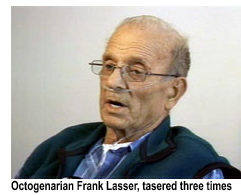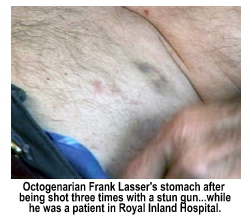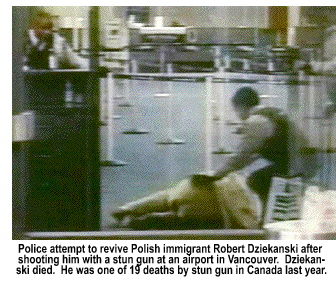
News
Behind the Headlines
Two-Cents Worth
Video of the Week
News Blurbs
Articles
Testimony
Bible Questions
Internet
Articles (2012)
Internet Articles (2011)
Internet Articles (2010)
Internet Articles
(2009)
Internet Articles (2008)
Internet Articles (2007)
Internet Articles (2006)
Internet Articles (2005)
Internet Articles (2004)
Internet Articles (2003)
Internet Articles (2002)
Internet Articles (2001)

RCMP
uses stun gun on 82-year old heart patient in
a Kamloops, British Columbia hospital.
Use of
stun guns in Canada has doubled.
An 82-year old Kamloops, British Columbia bypass recipient was rushed to Royal Inland Hospital on March 22, 2008 with emphysema aggravated by pneumonia. The patient, former prison guard Frank Lesser, suffered from a form of dementia triggered by his breathing difficulties. Lasser's breathing disorder required him to carry a portable oxygen tank at all times. Lasser entered the hospital as an inpatient through the emergency room. He was assigned a bed and an "air-conditioned" hospital gown.
 From
the sketchy and somewhat confusing details of the events that triggered
hospital personal to call the Royal Canadian Mounted Police [RCMP] Kamloops
detachment (and keeping in mind that Lasser had already been admitted
and was in a traditional hospital bed when the incident happened), a nurse
reported to the police that Lasser became delusional and pulled
a knife out of his pocket. (Since hospital gowns don't come with pockets,
its unclear what "pocket" Lasser pulled the knife from.)
It is clear, however, that when three RCMP officers from the Kamloops
detachment arrived in his room where the 82-year old man lay in bed, he
had a knife in his hand. Since he was delirious at the time, he's not
sure how he came to have it. He admitted he threatened the nurses whom
he felt were not doing enough to ease his breathing problems.
From
the sketchy and somewhat confusing details of the events that triggered
hospital personal to call the Royal Canadian Mounted Police [RCMP] Kamloops
detachment (and keeping in mind that Lasser had already been admitted
and was in a traditional hospital bed when the incident happened), a nurse
reported to the police that Lasser became delusional and pulled
a knife out of his pocket. (Since hospital gowns don't come with pockets,
its unclear what "pocket" Lasser pulled the knife from.)
It is clear, however, that when three RCMP officers from the Kamloops
detachment arrived in his room where the 82-year old man lay in bed, he
had a knife in his hand. Since he was delirious at the time, he's not
sure how he came to have it. He admitted he threatened the nurses whom
he felt were not doing enough to ease his breathing problems.
 When
Kamloops detachment RCMP Corporal Scott Wilson was interviewed
by CBC News, he said "...whether the person is 80 or 20, we are
dealing with a person who had a deadly weapon in [his] hand. We could
not deploy our pepper spray because we could potentially contaminate the
entire hospital." Instead, without knowing the extent of the
octogenarian patient's medical problems, the three police officers decided
the best way to handle an 82-year old bedridden patient in respiratory
distress was to shoot him with stun guns three times.
When
Kamloops detachment RCMP Corporal Scott Wilson was interviewed
by CBC News, he said "...whether the person is 80 or 20, we are
dealing with a person who had a deadly weapon in [his] hand. We could
not deploy our pepper spray because we could potentially contaminate the
entire hospital." Instead, without knowing the extent of the
octogenarian patient's medical problems, the three police officers decided
the best way to handle an 82-year old bedridden patient in respiratory
distress was to shoot him with stun guns three times.
Lasser said when the
RCMP officers entered his room he was prone, in bed (suggesting he was
likely not in bed when the incident with the nurses happened). Most likely,
Lasser got the pocket knife from his pants pocket hanging in the
closet in his room and waved it at the nurses who, in his mind, were ignoring
his distress. He said he was so weak and exhausted that the cops could
have easily disarmed him without the use of stuns guns.  "I
was laying on the bed by then and the corporal came in, or the sergeant,
and said to the guys: 'Okay, get him because we got more important work
to do on the street tonight.' And then, bang, bang, bang—three times
with the taser—and, I tell you, I never want that again. They said:
"That'll teach him to bring a knife into a hospital, then.'"
"I
was laying on the bed by then and the corporal came in, or the sergeant,
and said to the guys: 'Okay, get him because we got more important work
to do on the street tonight.' And then, bang, bang, bang—three times
with the taser—and, I tell you, I never want that again. They said:
"That'll teach him to bring a knife into a hospital, then.'"
Lasser still had the knife in his hand when the officers arrived but, according to him, he was no longer threatening anyone. According to reports, no effort was made by the officers to disarm the 82-year old man. The stun gun was simply the most expedient way to disarm him. As he lay in bed, he was shot in the stomach three times.
CBC News (the Canadian Broadcasting Corporation) reported that the number of RCMP stun gun incidents have more than doubled since 2005. According to news reports, Mounties across Canada used, or threatened to use, stun guns more than 1,400 times In 2006 compared to 597 times in 2005. In British Columbia (where the Lasser incident happened in March), stun gun incidents increased from 218 in 2005 to 496 last year. Although reports of greatly increased use of stun guns by Canadian police official have been confirmed by the Canadian news media, police agencies are less willing to share data about the use of stun guns with the media. According to CBC News, Mounties are required to complete a report anytime an officer uses, or threatens to use, a stun gun on a Canadian citizen. The report must include information about the incident and whether the person upon whom the stun gun is used appeared to be suffering from mental illness or was armed—and whether the action resulted in any type of injury.
Changes in the law in Canada
occurred last year when an immigrant to Canada from Gliwice, Poland, Robert
Dziekanski, was killed in a stun gun incident at the airport in Vancouver,
British Columbia. Dziekanski was headed to Kamloops to live with
his mother. Kamloops, of course, is where Frank Lasser tangled
with a stun gun in the hands of the RCMP. Video of the incident, caught on a traveler's cell phone, made it to YouTube
and was shown all over the world, triggering an investigation of the use
of stun guns by the Canadian government—and new legislation to force
more transparency by the police when stun guns are used. However, police
transparency is almost nonexistent according to Canadians who are criticizing
the federal law enforcement officers for their continued lack of transparency.
Video of the incident, caught on a traveler's cell phone, made it to YouTube
and was shown all over the world, triggering an investigation of the use
of stun guns by the Canadian government—and new legislation to force
more transparency by the police when stun guns are used. However, police
transparency is almost nonexistent according to Canadians who are criticizing
the federal law enforcement officers for their continued lack of transparency.
 "The
RCMP is a public police force," public safety critic and former
British Columbia Attorney General Ujjal Dosanjh told CBC News.
"They have to be on the up and up. They have to be transparent.
They have to be accountable. They have to provide that information so
that people can judge for themselves whether or not their police force
acted appropriately. The more I look at how [the RCMP] functions, the
more I see the lack of transparency and accountability."
"The
RCMP is a public police force," public safety critic and former
British Columbia Attorney General Ujjal Dosanjh told CBC News.
"They have to be on the up and up. They have to be transparent.
They have to be accountable. They have to provide that information so
that people can judge for themselves whether or not their police force
acted appropriately. The more I look at how [the RCMP] functions, the
more I see the lack of transparency and accountability."
Police agencies in the United States and elsewhere have somehow missed the purpose of the stun gun. When the weapon was designed by Taser International, it was designed as an alternative to deadly force in restraining violent suspects. Increasingly today it is used by police as a "gender equalizer." Lightweight female officers who should never have been put on the force let alone be assigned as street cops are armed with stun guns with the right to use them on any male suspect who even remotely resists them. Disabling suspects—even those who simply do not respond fast enough to orders to disperse, or disruptive elderly people whose only crime is being mentally disoriented and unresponsive—is increasingly being done with stun guns because it's more convenient and, as Cpl. Wilson in Kanloops said, "...we've got more important work to do on the street..."
Counting Dziekanski, there have been 19 stun gun-related deaths in Canada since 2001. In an analysis of 563 stun gun incidents investigated by the Canadian media from 2002 to 2005, three-fourths of the suspects were unarmed, defeating the original intent of the weapon—using nonlethal force to subdue violent suspects. The Canadian media is alarmed by the increased use of this deadly weapon by Canadian law enforcement officers on unarmed, merely unruly citizens—many of whom's only crime is being intoxicated. Media reports in the United States indicated that 180 people died in stun gun-related deaths in 2006.
The Canadian House of Commons Public Safety Committee is examining the growing use of stun guns. It plans to hear testimony from RCMP officers, customs officials and other affected people before drafting a report to Parliament. The RCMP argued that the use of stun guns saved 4,000 lives since police started using them. The spokesman for the RCMP, Troy Lightfoot, said the use of stun guns is appropriate, and enhances public safety. "And," he said, "it is one of the least injurious means that we have available to take people into police custody."
With respect to transparency, Lightfoot refused to comment why the RCMP is not providing the reports mandated by law. Other police officials maintain that the information is provided by the officers, but that the information is censored to protect the privacy of the people who had encounters with police. The long and short of it is that stun guns are potentially lethal weapons that are used by police officers to subdue nonviolent offenders and, in many cases, elderly people whose immune systems are compromised. Police officers who use stun guns on unarmed, nonbelligerent offenders who are stunned because they don't respond fast enough should be charged with assault, or fired. In the event that nonviolent, unarmed offenders die after being shot with a stun gun, the police officer must be charged with negligent homicide caused by unnecessary force.
Once again, you have my two cents worth on this issue.



Copyright © 2009 Jon Christian Ryter.
All rights reserved.


